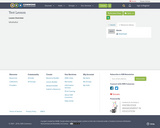
fdfsdfsdfsd
- Subject:
- Architecture and Design
- Material Type:
- Lesson Plan
- Author:
- Sarah Weston
- Date Added:
- 04/05/2018

fdfsdfsdfsd
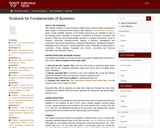
The testbank includes 377 peer-reviewed, multiple-choice questions which correspond to topics taught in introductory-level business open textbook, "Fundamentals of Business." "Fundamentals of Business" is a freely available, openly licensed resource available at: http://hdl.handle.net/10919/84848 .
Between 11-29 multiple-choice items are available for each of the following topics: Teamwork in Business, Foundations of Business, Economics and Business, Ethics and Social Responsibility, Business in a Global Environment, Forms of Business Ownership, Entrepreneurship: Starting a Business, Management and Leadership, Structuring Organizations, Operations Management, Motivating Employees, Managing Human Resources, Union/Management Issues, Marketing: Providing Value to Customers, Pricing Strategy, Hospitality and Tourism, Accounting and Financial Information, and Personal Finances.
The testbank is available to any instructor who has adopted Fundamentals of Business in their course. Please complete the four steps listed at http://hdl.handle.net/10919/93404 to request access to the testbank.
1. View and test the "sample" files at http://hdl.handle.net/10919/93404 in the left hand column to determine which format works best for you. Additional information about each format type is available below under FORMATS.
2. Indicate requested files by clicking on any of the testbank files at http://hdl.handle.net/10919/93404 on the left (marked "permission required") add a note and press submit to request access.
3. Email a copy of the course syllabus to openeducation@vt.edu
4. Complete and submit the User Verification Process Form https://forms.gle/ueaihc96LgNrE9uf9. You will receive a copy of your request via email.
Requested files will be released via email when steps two through four have been completed and reviewed. Note that access approvals are processed only during regular business hours.
Please visit: http://hdl.handle.net/10919/93404 for Terms of Use, license information, and to view or report errata.
SAMPLE QUESTIONS
Sample questions are available for those who wish to test various formats and assess the suitability of the testbank as part of their course material adoption decision-making process. Sample questions are provided in the same formats (XLS, Canvas IMS QTI 1.1.3, XML QTI, and Blackboard formats) as the permission-only testbank files. Sample questions have been removed from the electronically secure testbank.
FORMATS
The testbank and portions thereof are available in multiple formats. Links to external sites regarding uploading different types of QTI files are here: Canvas | Blackboard or on the help pages for your respective learning management system by searching for "QTI". Files marked "IMS QTI 1.1.3" and have been tested to successfully import into Canvas but may work with other LMS/VLE systems. Please use the sample files to determine if one of the export formats will work for your specific situation. Please note that we are unable to provide additional file types, support for uploading, or assistance with reformatting files. Please contact your local learning management system (LMS) manager for additional support.
Distribution
The information in the testbank is of a proprietary nature, produced by or for faculty of public institutions of higher education as a result of collaborative study, research, and peer review. Because it is intended to be used in student assessment the information has not been publicly released or published.
If you become aware of public distribution of the testbank or portions thereof shared outside of a secure electronic environment, assessment context, or other security breach please inform us at: openeducation@vt.edu
LIABILITY
The testbank and testbank items are provided "as is." Users of this resource assume all risks and further agree to hold Virginia Tech, the Commonwealth of Virginia and their employees and agents, and project contributors harmless from any and all actions related to use of this program.

DirectionsYou Tube
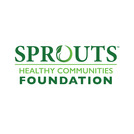
In this engaging unit, students will design and plant a square-foot garden that will be their central tool. Through the growing season, they will explore nutrition content in their everyday lives and see how it relates to what they are growing.

In this engaging unit, students will design and plant a square-foot garden that will be their central tool. Through the growing season, they will explore nutrition content in their everyday lives and see how it relates to what they are growing.
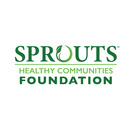
In this engaging unit, students will design and plant a square-foot garden that will be their central tool. Through the growing season, they will explore nutrition content in their everyday lives and see how it relates to what they are growing.
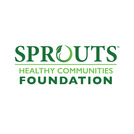
In this engaging unit, students will design and plant a square-foot garden that will be their central tool. Through the growing season, they will explore nutrition content in their everyday lives and see how it relates to what they are growing.

In this engaging unit, students will design and plant a square-foot garden that will be their central tool. Through the growing season, they will explore nutrition content in their everyday lives and see how it relates to what they are growing.
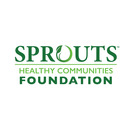
In this engaging unit, students will design and plant a square-foot garden that will be their central tool. Through the growing season, they will explore nutrition content in their everyday lives and see how it relates to what they are growing.
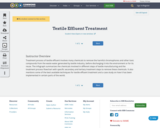
Treatment process of textile effluent involves many chemicals to remove the harmful chromophores and other toxic compounds from the waste water generated by textile industry, before discharging it into the environment or for its reuse. The infograph summarizes the chemicals involved in different steps of textile manufacturing and the treatment process flowchart with specific secondary and tertiary treatment steps to remove these chemicals. It also mentions some of the best available techniques for textile effluent treatment and a case study on how it has been implemented in certain parts of the world.
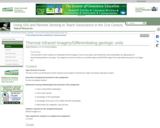
This lab introduces students to Thermal infrared Imagery and then asks them to evaluate which wavelengths (VIS, NIR, SWIR, or TIR) are the best choices to identify and discriminate between geologic materials. The lab focuses on the Geology in the Lake Mead Region east of Las Vegas, NV; the lab uses a Landsat image and a MASTER image of the area. Students get experience with a classic band combination using TIR to identify rock types and with making decisions on which wavelengths to use in identifying surface materials.
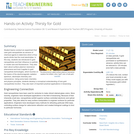
Student teams conduct an experiment that uses gold nanoparticles as sensors of chemical agents to determine which of four sports drinks has the most electrolytes. In this way, students are introduced to gold nanoparticles and their influence on particle or cluster size and fluorescence. They also learn about surface plasmon resonance phenomena and how it applies to gold nanoparticle technologies, which touches on the basics of the electromagnetic radiation spectrum, electrolyte chemistry and nanoscience. Using some basic chemistry and physics principles, students develop a conceptual understanding of how gold nanoparticles function. They also learn of important practical applications in biosensing.
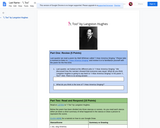
Student will read and study Hughes' poem, "I, Too" and identify the tone in the poem.

In this lesson, students will view Wendy Troxel's TEd Talk, "Why School Should Start Later for Teens." While viewing the TED Talk, students will identify and trace the main parts of her argument.
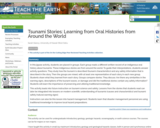
In this jigsaw activity, students are placed in groups. Each group reads a different written record of an indigenous oral history about tsunamis. These indigenous stories are from around the world. To guide their interpretations, students answer activity questions. They study how the tsunami is described (tsunami characteristics) and any safety information that is described in the story. Then the groups are mixed, with at least one representative of each story in each new group. Students share what they learned from each story. Groups compare stories. They discuss: Are there any similarities in the warning signs, descriptions of the tsunami waves, or damage and did the traditional stories contain any safety information? Students will learn the importance of preserving and utilizing traditional knowledge.
This activity leads into future instruction on tsunami science and safety. Lessons from the stories that students read can later be integrated into lessons on modern scientific understanding of tsunamis (causes and characteristics) and tsunami safety (natural warning signs).
Instructors can also tie this lesson into hazard management. Students learn that disaster management personnel are using traditional knowledge to improve local hazard preparations.

The General Biology course collection, as the name suggests, is not a course, but rather a collection of activities and resources that an online instructor could use to supplement their online course. There are resources for both micro and macro biology which could be used to bolster understanding within lecture-based courses or added to specific online labs depending on the student learning outcomes.
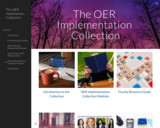
The OER Implementation Collection is a companion to the UNC digital course enhancement collections. It was developed for faculty, instructors, and librarians in the UNC System by open educational resources (OER) experts from NC State University, East Carolina University, UNC Greensboro, UNC Charlotte, North Carolina A&T, University of North Carolina School of the Arts, and UNC Chapel Hill.
The collection gathers reliable open resources and provides videos of presentations from authoritative speakers to answer the most frequent questions faculty ask about how and why to use OER in their courses. The OER Implementation Collection will provide a guide to finding and using OER for faculty and instructors who are interested in working with the UNC digital course enhancement collections and using other open educational resources in their teaching.
After using this collection, participants will:
Understand what OER are
Describe how OER benefit students and faculty
Find OER that are relevant for their courses
Determine quality and value of OER that they find
Adapt existing OER to fit their courses
Learn how to create their own OER

In this introductory unit, students will learn about the fundamental role of observation by viewing photographs of both agricultural and non-agricultural (natural) landscapes and making independent observations. They will learn how to relate physiographic features to land use by drawing conclusions about how the physiography of the land affects or is affected by various land use practices. They will then discuss their observations in small groups, organize their thoughts, and explain their conclusions in a classroom oral presentation. Finally, students will consider landscape features in the context of Earth systems and discuss how these systems are impacted by human activity.
(Note: this resource was added to OER Commons as part of a batch upload of over 2,200 records. If you notice an issue with the quality of the metadata, please let us know by using the 'report' button and we will flag it for consideration.)
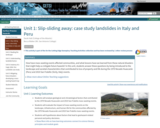
How have mass-wasting events affected communities, and what lessons have we learned from these natural disasters that might help us mitigate future hazards? In this unit, students answer these questions by being introduced to the landscape and societal characteristics that contributed to loss of property and life during the 1970 Nevado HuascarÃn (Peru) and 2010 San Fratello (Sicily, Italy) events.
Show more about Online Teaching suggestions
Hide
Online-ready: This opening class discussion about landslides and societal impacts could easily be converted to an online discussion format.
(Note: this resource was added to OER Commons as part of a batch upload of over 2,200 records. If you notice an issue with the quality of the metadata, please let us know by using the 'report' button and we will flag it for consideration.)
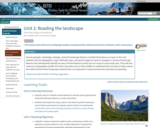
How do geologic, hydrologic, biologic, and built-landscape features manifest themselves on maps? In this unit, students will use topographic maps, hillshade maps, and aerial imagery to learn to recognize a variety of landscape features and subsequently identify as many of these features as they can on a map of a new study area. They will also construct a topographic profile from their map data and use their profiles to understand the concepts of slope, aspect, and relief and how these landscape characteristics are important in hazard assessment and land-use planning.
Show more about Online Teaching suggestions
Hide
Online-adaptable: Part 1 (lecture) and Part 3 (individual or small-group exercise) are particularly straight forward to adapt to online. The landscape scavenger hunt exercise, Part 2, is typically done with printed maps but can be successfully adapted to online by having synchronous groups of students work together to annotate digital map files using: 1) PDF annotation tools in Adobe or 2) putting the map images into a Google Slides file and using the scribble tool. Google Earth files are also provided as an additional option.
(Note: this resource was added to OER Commons as part of a batch upload of over 2,200 records. If you notice an issue with the quality of the metadata, please let us know by using the 'report' button and we will flag it for consideration.)